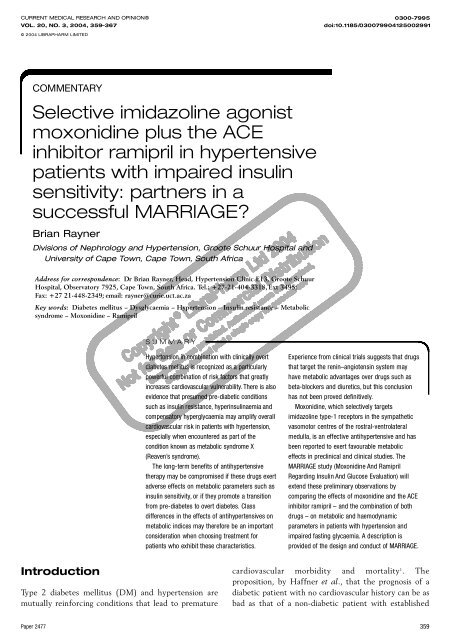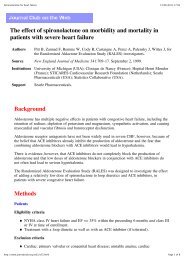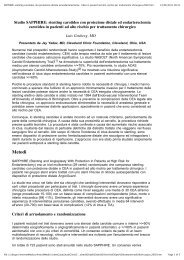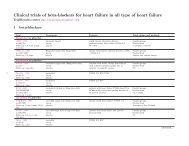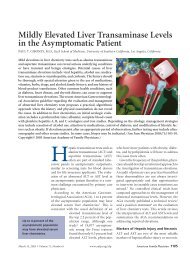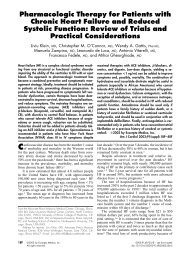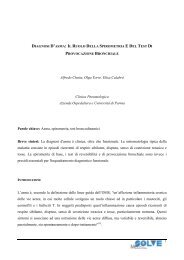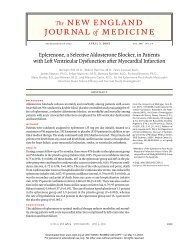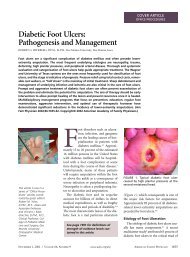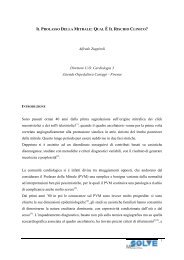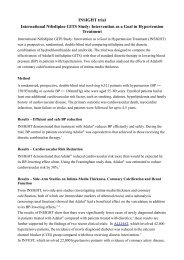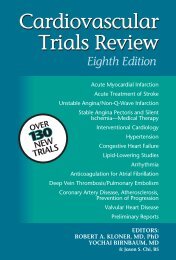MARRIAGE study - Diegori.it
MARRIAGE study - Diegori.it
MARRIAGE study - Diegori.it
Create successful ePaper yourself
Turn your PDF publications into a flip-book with our unique Google optimized e-Paper software.
Diabetes), FACET (Fosinopril versus AmlodipineCardiovascular Events Trial), and the CaptoprilPrevention Project (CAPPP) – suggested a substantialbenef<strong>it</strong> of ACE inhib<strong>it</strong>or therapy over other classes ofantihypertensives on several major outcomes, includingcardiovascular events in patients w<strong>it</strong>h hypertension plusDM 27 .CAPPP, which was the largest of these threestudies and in which the comparator medications toACE inhib<strong>it</strong>ors were diuretics and/or beta-blockers,showed no difference in the primary outcome ofnon-fatal or fatal myocardial infarction (MI), or instroke or other cardiovascular deaths dep<strong>it</strong>e persistinghigher blood pressure in patients receiving the ACEinhib<strong>it</strong>or (there was a non-significant trend for fewercardiovascular deaths w<strong>it</strong>h captopril) 28 . Captopril wasmarkedly superior to conventional therapy in theprevention of several cardiovascular outcomes (notstroke) in patients w<strong>it</strong>h DM at baseline. The clinicalsuperior<strong>it</strong>y of captopril in this subset of patients wasmost marked in those w<strong>it</strong>h evidence of poor glycaemiccontrol 29 .Separately, the results of UKPDS 39, a companion<strong>study</strong> to UKPDS 38, indicated that patients who usedcaptopril were significantly less likely to requireadd<strong>it</strong>ional hypoglycaemic agents and to have lowerlevels of glycosylated haemoglobin than patients whotook atenolol 30 . These were observations stronglysuggestive of better glycaemic control w<strong>it</strong>h the ACEinhib<strong>it</strong>or than w<strong>it</strong>h the beta-blocker. Average weightgain among atenolol-treated patients in UKPDS 39 wasalmost double that in the patients who receivedcaptopril, however, and may have contributed to theprofile of poor glycaemic control among the betablockercohort. This complicates analysis of thedifference between the two treatment regimens.Diuretic Therapy: Contentious Evidencefrom ALLHATConfounding influences also complicate analysis ofALLHAT 17 . This was not expressly a <strong>study</strong> inhypertensive patients w<strong>it</strong>h DM, but 36% of patientssatisfied that defin<strong>it</strong>ion and the controversy that hasaccompanied the publication and interpretation of this<strong>study</strong> is such that a discussion of <strong>it</strong>s salient features iscalled for. On first encounter the results of this <strong>study</strong>seem to contradict the evidence of trials such asCAPPP 28 by suggesting a superior<strong>it</strong>y of diuretic(specifically chlorthalidone) therapy over an ACEinhib<strong>it</strong>or (lisinopril). In fact, this putative difference wasnot evident for the <strong>study</strong> primary endpoint and waslargely accounted for by non-fatal heart failure (the highincidence of which in the lisinopril group may well havebeen due to the abrupt w<strong>it</strong>hdrawal of pre-<strong>study</strong>diuretics) and by stroke. This last endpoint is theoutcome most closely related to BP, making thesustained lower BPs in the chlorthalidone versuslisinopril groups a matter of more than academicimportance: during ALLHAT systolic BP in the lisinoprilgroup was 1.6–3.1 mmHg higher than in thechlorthalidone group. It should be recalled that inCAPPP also, ACE inhib<strong>it</strong>or therapy did not reduce theincidence of stroke more than other therapies.In connection w<strong>it</strong>h the BP differential in ALLHAT <strong>it</strong>should be noted that much of the impression thatlisinopril was associated w<strong>it</strong>h worse outcomes thanchlorthalidone arose from the outcomes in blackAmericans, a group in which use of an ACE inhib<strong>it</strong>orunsupported by a diuretic would ordinarily bedeprecated 4 . Finally, <strong>it</strong> may be observed that amongpatients w<strong>it</strong>h DM at baseline chlorthalidone andlisinopril were closely equivalent for most endpointsincluding combined coronary and cardiovascular disease,a result that, bearing in mind the sustained inter-groupdifferences in BP, suggests other, non-haemodynamicmechanisms may have been in operation.Alpha-adrenoceptor Agents: Good inPrinciple, Less Good in PracticeALLHAT has also provided an important recentperspective on the use of peripherally acting alpha 1-blockers in hypertension. Doxazosin is probably themost widely used of these agents and has been reportedto exert favourable or neutral effects on glucose, insulinand lipids 31–33 . The decision to discontinue the doxazosinarm of the ALLHAT <strong>study</strong> because of excess heartfailure-related mortal<strong>it</strong>y relative to chlorthalidone 17 has,however, rightly eclipsed considerations of metabolicprofile and serves as a reminder that theoretical ancillarybenef<strong>it</strong>s do not compensate for lack of core clinicaleffectiveness. Whether or not the particularcircumstances of the ALLHAT <strong>study</strong> contributed to thisunexpected outcome is hard to determine at present.Centrally acting alpha-agonists such as clonidine havelong been cred<strong>it</strong>ed w<strong>it</strong>h a relatively favourable effect onmetabolic indices. The overall adverse effect profile ofthis drug is such, however, that <strong>it</strong> has largely passed outof routine use in the management of hypertension. Theavailabil<strong>it</strong>y of a transdermal preparation appears not tohave materially affected this trend 34 .Effects of ARB Therapy: The LIFE StudyImportant clinical benef<strong>it</strong>s of angiotensin-targetedtherapies emerged from the LIFE (LosartanIntervention For Endpoint reduction in hypertension)<strong>study</strong> 35 . This large trial (n > 9000) evaluated the impactof the angiotensin receptor blocker (ARB) losartan on© 2004 LIBRAPHARM LTD – Curr Med Res Opin 2004; 20(3) Moxonidine and ramipril: partners in a successful <strong>MARRIAGE</strong>? Rayner 361
Table 2. Comparison of the incidence of new-onset diabetes mell<strong>it</strong>us (DM) in controlled trials of antihypertensive drug therapiesStudy Drug(s) compared Duration (years) New-onset DM (rate, %)*ALLHAT ACEI vs. CCB vs. Diu 4.9 8.1 vs. 9.8 vs. 11.6ALPINE ARB (± CCB) vs. Diu (± BB) 1.0 0.5 vs. 4.1CAPPP ACEI vs. BB/Diu 6.1 6.5 vs. 7.3HOPE ACEI vs. placebo 4.5 3.6 vs. 5.4INSIGHT CCB vs. Diu 3.5 4.3 vs. 5.6LIFE** ARB vs. BB 4.8 6.0 vs. 8.0NORDIL CCB vs. BB/Diu 4.5 4.3 vs. 4.9SCOPE ARB vs. Diu 3.7 4.3 vs. 5.3ALLHAT = Antihypertensive and Lipid-Lowering Therapy to Prevent Heart Attack Trial 17 ; ALPINE =Antihypertensive Treatment and Lipid Profile in a North of Sweden Efficacy Evaluation 47 ; CAPPP =Captopril Prevention Project 28 ; HOPE = Heart Outcomes Protection Evaluation 40 ; INSIGHT =Intervention as a goal in hypertension treatment 43 ; LIFE = Losartan Intervention For Endpointreduction in hypertension 35 ; NORDIL = Nordic Diltiazem 44 ; SCOPE = Study on Cogn<strong>it</strong>ion andPrognosis in the Elderly 45*p < 0.05 for all results except NORDIL and SCOPE (n.s.)**Diuretic used by > 80% patientsACEI = ACE inhib<strong>it</strong>or; ARB = angiotensin receptor blocker; BB = beta-blocker; CCB = calcium-channelblocker; Diu = diureticPrognostic impact ofmetabolic effectsThese observations on the differing metabolic effects ofvarious types of antihypertensives may have long-termclinical significance. As Julius et al. 48 have remarked,controlled trials to date have concentrated on patientsw<strong>it</strong>h established DM, which in effect is intervention at theend-stage of the disease process. The value of earlierintervention to prevent the development of overt DM orto moderate the risk associated w<strong>it</strong>h pre-diabetic statessuch as impaired insulin sens<strong>it</strong>iv<strong>it</strong>y is as yet unquantifiedbut, in view of the way in which DM and hypertensioninteract to inflate cardiovascular risk, <strong>it</strong> is plausible thatsuch an intervention might have great long-term benef<strong>it</strong>s.The importance of this possibil<strong>it</strong>y is acknowledged in thelatest guidelines of the European Society of Hypertension,in which <strong>it</strong> is noted that, ‘Treatment-induced alterations ofmetabolic parameters, such as… induction or worsening ofthe metabolic syndrome or diabetes, although they canhardly be expected to increase cardiovascular eventincidence during the short term of a trial, may have animpact during the longer course of the patient’s life… 4 ’.The number of people w<strong>it</strong>h DM is projected to increase tomore than 220 million by 2010, and a substantialproportion of these people will also have hypertension 49–51 .Even a modest favourable impact of medication on theprogression to full-blown DM may therefore produce verylarge public health gains.Therapeutic potential of SIRAsFurther <strong>study</strong> of the influence of antihypertensivetherapies on insulin sens<strong>it</strong>iv<strong>it</strong>y in hypertension is clearlywarranted and desirable. Angiotensin-specific agents areobvious candidates for further evaluation, but recentresearch has indicated that moxonidine, an exemplar ofthe selective imidazoline receptor agonists (SIRAs),mer<strong>it</strong>s closer scrutiny. The drug is an effectiveantihypertensive 52–57 and appears to have encouragingmetabolic effects 58–65 . Moreover, pathophysiologicalconsiderations suggest that there may be opportun<strong>it</strong>iesfor synergy between SIRAs and drugs that act viaangiotensin, synergies that may be explo<strong>it</strong>ed to theadvantage of patients.Moxonidine Effects on Glycaemic Indices:Preclinical DataMoxonidine has been shown to partially restore glucosetolerance in fructose-fed rats subjected to a glucose loadand to normalize insulin levels in this model 58 . Similareffects have been reported in the Koletsky obesespontaneously hypertensive rat (SHROB) 59 . Laterstudies in this animal model of metabolic syndromeproduced evidence of increased sympathetic nervousactiv<strong>it</strong>y as a common denominator in both hypertensionand insulin resistance, and also provided evidence thatmoxonidine both lowered BP and improved glycaemiccontrol 60 . Similar observations have been reported inother animal models 61 .In add<strong>it</strong>ion to direct interaction between thesympathetic nervous system and the renin–angiotensinsystem, there is potential for the interplay of bothpathways w<strong>it</strong>h insulin 60,62 . The outlines of a possiblecomplementary effect of angiotensin-targeted therapiesand SIRAs on insulin sens<strong>it</strong>iv<strong>it</strong>y may be discerned inthese interactions. An instructive comparison may alsobe made between SIRAs and beta-blockers. Drugs ofboth classes are sympatholytic. However, beta-blockers© 2004 LIBRAPHARM LTD – Curr Med Res Opin 2004; 20(3) Moxonidine and ramipril: partners in a successful <strong>MARRIAGE</strong>? Rayner 363
act peripherally, w<strong>it</strong>h one of their effects being to bluntinsulin-mediated glucose transport into skeletal muscles(i.e. they impair insulin sens<strong>it</strong>iv<strong>it</strong>y). The centrally actingSIRAs reduce sympathetic outflow but not at theexpense of insulin sens<strong>it</strong>iv<strong>it</strong>y.Moxonidine Effects on Glycaemic Indices:Clinical DataHaenni and L<strong>it</strong>hell 63 conducted a placebo-controlleddouble-blind trial in insulin-resistant obese patientsw<strong>it</strong>h mild hypertension and reported an improvement inthe insulin sens<strong>it</strong>iv<strong>it</strong>y index following moxonidinetherapy (Figure 1), as well as an increase in the rate ofglucose infusion during a euglycaemic clamp test. Therewas also a reduction in fasting plasma glucose amongsubjects treated w<strong>it</strong>h moxonidine. Add<strong>it</strong>ional evidencefor effects of moxonidine on glucose and insulinmetabolism in humans emerged from work by Almazovet al. 64 , who described improvements in tissue insulinsens<strong>it</strong>iv<strong>it</strong>y and a reduction in the total area-under-thecurve(AUC) for insulin response to an oral glucose loadin hypertensive patients, and by Sanjuliani andcolleagues 65 , who demonstrated both a reduction inplasma insulin 2 h after an oral glucose tolerance test(OGTT) in non-diabetic hypertensive patients treatedw<strong>it</strong>h moxonidine and a correlation between a reductionin insulin levels and a decline in plasma noradrenalinelevels.Parallel observations by Almazov and co-workers 64that metformin (administered to hypertensive patientsw<strong>it</strong>h impaired glucose tolerance) lowered BP inproportion to <strong>it</strong>s effect on glycaemic status, togetherw<strong>it</strong>h reports that the insulin-sens<strong>it</strong>izer rosigl<strong>it</strong>azonelowers BP 66 and, conversely, that various drugs enhanceinsulin sens<strong>it</strong>iv<strong>it</strong>y secondary to reducing BP, emphasizeChange (%)2520151050-5-10MM/IP = 0.026 P = 0.056n.s.P = 0.004 P = 0.027PlaceboFigure 1. Use of moxonidine (0.2mg b.i.d. for 8 weeks) wasassociated w<strong>it</strong>h significant increases in glucose infusion rate (M)and insulin sens<strong>it</strong>iv<strong>it</strong>y index (M/I) during an euglycaemicclamp test in patients (n = 38) w<strong>it</strong>h mild hypertension, reducedinsulin sens<strong>it</strong>iv<strong>it</strong>y (baseline M/I < 3.6) and body massindex > 27kg/m 2 . (Reproduced, w<strong>it</strong>h permission, from Ref. 63.)n.s.Moxonidinethe reciprocal nature of relations between BP andinsulin sens<strong>it</strong>iv<strong>it</strong>y. The sympathetic nervous system andthe renin–angiotensin system are probable mediators ofthis interconnection.The <strong>MARRIAGE</strong> <strong>study</strong>A controlled clinical <strong>study</strong> of the impact of ACEinhib<strong>it</strong>ion and SIRA therapy on glycaemic control is nowunderway. The <strong>MARRIAGE</strong> <strong>study</strong> (Moxonidine AndRamipril Regarding Insulin And Glucose Evaluation) hasbeen designed to compare the effects of moxonidine andramipril on BP and glycaemic control in overweightpatients w<strong>it</strong>h mild–moderate hypertension and impairedfasting glycaemia. Inclusion cr<strong>it</strong>eria for this <strong>study</strong> aresummarized in Table 3.The primary endpoint of <strong>MARRIAGE</strong> is the responseof s<strong>it</strong>ting diastolic BP (SiDBP) to monotherapy w<strong>it</strong>hmoxonidine (0.4 mg/day, the preferred maintenancedose) or ramipril (5 mg/day), or the combination of bothdrugs in those patients who require such therapy (Figure2). Patients are considered to have a satisfactoryresponse to therapy if SiDBP is reduced by at least 10%relative to baseline; normalization of SiDBP is defined asa reduction to less than 85 mmHg.Secondary endpoints of <strong>MARRIAGE</strong> include a rangeof indices of glucose homoeostasis: fasting glucose andinsulin levels; glucose and insulin levels after an OGTT(AUC and values at 0, 0.5, 1 and 2 h); and glycosylatedhaemoglobin. Response to therapy will be tested after12 and 24 weeks of treatment, w<strong>it</strong>h comparisons versusbaseline and between treatment groups.<strong>MARRIAGE</strong> will also provide an opportun<strong>it</strong>y for thefurther evaluation of the safety and tolerabil<strong>it</strong>y ofmoxonidine as part of combination therapy. Experienceto date has been favourable and the drug has been usedsuccessfully w<strong>it</strong>h exemplars of several other majorclasses of antihypertensives 68 . The acquis<strong>it</strong>ion of furtherdata is nevertheless desirable in an era when multidrugtherapy for hypertension is regarded as necessary for amajor<strong>it</strong>y of patients.Table 3. Inclusion cr<strong>it</strong>eria for the <strong>MARRIAGE</strong> <strong>study</strong>1. Standard office s<strong>it</strong>ting diastolic blood pressure85–109 mmHg and/or systolic blood pressure140–179 mmHg.2. Impaired fasting glycaemia or diabetes mell<strong>it</strong>us(fasting plasma glucose 110 mg/dl to < 126 mg/dl[ 6.1 mmol/l<strong>it</strong>re to < 7 mmol/l<strong>it</strong>re])* or diabetesmell<strong>it</strong>us (fasting plasma glucose 26 mg/dl[ 7 mmol/l<strong>it</strong>re]) treated w<strong>it</strong>h diet alone.3. Body mass index > 25.0 kg/m 2 to < 35.0 kg/m 2 .*Defined according to cr<strong>it</strong>eria published by the AmericanDiabetes Association 67364 Moxonidine and ramipril: partners in a successful <strong>MARRIAGE</strong>? © 2004 LIBRAPHARM LTD – Curr Med Res Opin 2004; 20(3)
12-week double-blind comparison: moxonidine vs. ramipril 12-week combination treatment: moxonidine + ramiprilPlacebo run-inWeek: -2 0 12 24PrescreeningScreening/randomization<strong>MARRIAGE</strong> is being conducted at s<strong>it</strong>es in France(Professor P. Valensi, CHU Jean Verdier, Paris) andGermany (Dr. J. Jordan, Berlin-Buch). Recru<strong>it</strong>ment isexpected to be completed by the end of 2003, by whichtime <strong>it</strong> is anticipated that approximately 200 patientswill have been randomized. Results from this <strong>study</strong> willbe available in 2004 and may prove highly instructive inhelping to shape new treatment strategies for patientswho have hypertension and impaired insulin sens<strong>it</strong>iv<strong>it</strong>y.Comparison of the results of <strong>MARRIAGE</strong> w<strong>it</strong>h those ofDREAM (Diabetes Reduction Assessment w<strong>it</strong>hRamipril and Rosigl<strong>it</strong>azone) 49 may also provide usefulinsights into new treatment strategies for patients w<strong>it</strong>hhypertension and impaired insulin sens<strong>it</strong>iv<strong>it</strong>y. Inadd<strong>it</strong>ion, these studies may provide valuable add<strong>it</strong>ionalinformation about the relation between impairedglucose tolerance and frank DM.ConclusionsMoxonidine 0.4 mg ODRamipril 5 mg ODFigure 2. Outline protocol of the <strong>MARRIAGE</strong> <strong>study</strong>There are indications that certain types ofantihypertensives – notably those that target therenin–angiotensin system but possibly also the SIRAs –may have effects on glucose and insulin metabolism thatcan substantially improve the long-term clinicalprognosis of patients w<strong>it</strong>h metabolic syndrome orhypertension w<strong>it</strong>h DM. The <strong>MARRIAGE</strong> <strong>study</strong> is beingundertaken, to ascertain, among other things, whateffects the combination of a SIRA (moxonidine) w<strong>it</strong>h anACE inhib<strong>it</strong>or (ramipril) has on indices of glycaemiccontrol in hypertensive patients w<strong>it</strong>h impaired fastingglycaemia.AcknowledgmentCombination forNon-respondersPreparation of this manuscript was assisted by anunrestricted educational grant from SolvayPharmaceuticals GmbH, Hannover, Germany.References1. Stamler J, Vaccaro O, Neaton JD, et al. Diabetes, other riskfactors and 12-year mortal<strong>it</strong>y for men screened in the multiplerisk factor intervention trial. Diabetes Care 1993;16:434-442. Haffner SM, Lehto S, Ronnemaa T, et al. Mortal<strong>it</strong>y fromcoronary heart disease in subjects w<strong>it</strong>h type 2 diabetes and innondiabetic subjects w<strong>it</strong>h and w<strong>it</strong>hout prior myocardialinfarction. N Engl J Med 1998;339:229-343. Becker A, Bos G, de Vegt F, et al. Cardiovascular events in type2 diabetes: comparison w<strong>it</strong>h nondiabetic individuals w<strong>it</strong>hout andw<strong>it</strong>h prior cardiovascular disease – 10-year follow-up of theHoorn Study. Eur Heart J 2003;24:1406-34. Guidelines Comm<strong>it</strong>tee. 2003 European Society of Hypertension– European Society of Cardiology guidelines for the managementof arterial hypertension. J Hypertens 2003;21:1011-535. Reaven GM. Role of insulin resistance in human disease. Diabetes1988;37:1595-6076. Reaven G. Syndrome X 10 years after. Drugs 1999;58(Suppl1):19-207. Expert Panel on Detection, Evaluation and Treatment of HighBlood Cholesterol in Adults. Executive summary of the ThirdReport of the National Cholesterol Education Program (NCEP)on detection, evaluation and treatment of high blood cholesterolin adults. JAMA 2001;285:2486-978. Ford ES, Giles WH, Dietz WH. Prevalence of the metabolicsyndrome among US adults. Findings from the Third NationalHealth and Nutr<strong>it</strong>ion Examination Survey. JAMA 2002;287:356-99. Pyörälä K. Relationship of glucose tolerance and plasma insulin tothe incidence of coronary heart disease: results from twopopulation studies in Finland. Diabetes Care 1979;2:131-4110. Gerstein HC. A disturbed glucose metabolic state(dysglycaemia) is a key factor for cardiovascular events. EurHeart J 2003;24(Suppl B):B1-B211. Hanefeld M, Fischer S, Julius U, et al. Risk factors for myocardialinfarction and death in newly detected NIDDM: the DiabetesIntervention Study, 11-year follow-up. Diabetologia1996;39:1577-8312. Haffner SM, Stern MP, Hazuda HP, et al. Cardiovascular riskfactors in confirmed prediabetic individuals. Does the clock forcoronary heart disease start ticking before the onset of diabetes?JAMA 1990;263:2893-813. Coutinho M, Gerstein HC, Wang Y, Yusuf S. The relationshipbetween glucose and incident cardiovascular events. Ametaregression analysis of published data from 20 studies of95,783 individuals followed for 12.4 years. Diabetes Care1999;22:233-4014. UK Prospective Diabetes Study Group. Tight blood pressurecontrol and risk of macrovascular and microvascular complicationsin type 2 diabetes: UKPDS 38. BMJ 1998;317:703-1315. L<strong>it</strong>hell HO, Andersson PE. Antihypertensive treatment in insulinresistant patients. Hypertens Res 1996;19(Suppl 1):S75-S7916. Moan A, Hoieggen A, Nordby G, Eide IK, Kjeldsen SE. Effectsof losartan on insulin sens<strong>it</strong>iv<strong>it</strong>y in severe hypertension:connections through sympathetic nervous system activ<strong>it</strong>y? J HumHypertens 1995;9(Suppl 5):S45-5017. The ALLHAT Officers and Coordinators for the ALLHATCollaborative Research Group. Major outcomes in high-riskhypertensive patients randomized to angiotensin-convertingenzyme inhib<strong>it</strong>or or calcium channel blocker vs diuretic. JAMA2002;288:2981-9718. Weidmann P. Metabolic profile of indapamide sustained-releasein patients w<strong>it</strong>h hypertension: data from three randomiseddouble-blind studies. Drug Safety 2001;25:1155-6519. Metheson AJ, Cheer SM, Goa KL. Perindopril/indapamide2/0.635 mg/day: a review of <strong>it</strong>s place in the management ofhypertension. Drugs 2001;61:1211-2920. Krum H, Skiba M, Gilbert RE. Comparative metabolic effects ofhydrochlorothiazide and indapamide in hypertensive diabeticpatients receiving ACE inhib<strong>it</strong>or therapy. Diabetes Med2003;20:708-1221. Spence JD, Huff M, Barnett PA. Effects of indapamide versushydrochlorothiazide on plasma lipids and lipoproteins inhypertensive patients: a direct comparison. Can J Clin Pharmacol2000;7:32-7© 2004 LIBRAPHARM LTD – Curr Med Res Opin 2004; 20(3) Moxonidine and ramipril: partners in a successful <strong>MARRIAGE</strong>? Rayner 365
22. Jacob S, Rett K, Henriksen EJ. Antihypertensive therapy andinsulin sens<strong>it</strong>iv<strong>it</strong>y: do we have to redefine the role of betablockingagents? Am J Hypertens 1998;11:1258-6523. Reneland R, Alvarez E, Andersson PL, et al. Induction of insulinresistance by beta-blockade but not by ACE-inhib<strong>it</strong>ion: long-termtreatment w<strong>it</strong>h atenolol or trandolapril. J Hum Hypertens2000;14:175-8024. Hansson L, Zanchetti A, Carruthers SG, et al. for the HOTStudy Group. Effects of intensive blood-pressure lowering andlow-dose aspirin in patients w<strong>it</strong>h hypertension: principal resultsof the Hypertension Optimal Treatment (HOT) randomisedtrial. Lancet 1998;351:1755-6225. SHEP Cooperative Research Group. Prevention of stroke byantihypertensive drug treatment in older persons w<strong>it</strong>h isolatedsystolic hypertension. Final results of the systolic hypertension inthe elderly program (SHEP). JAMA 1991;265:3255-6426. Psaty BM, Sm<strong>it</strong>h NL, Siscovick DS, et al. Health outcomesassociated w<strong>it</strong>h antihypertensive therapies used as first-lineagents a systematic review and meta-analysis. JAMA1997;277:739-4527. Pahor M, Psaty BM, Alderman MH, et al. Therapeutic benef<strong>it</strong>s ofACE inhib<strong>it</strong>ors and other antihypertensive drugs in patients w<strong>it</strong>htype 2 diabetes. Diabetes Care 2000;23:888-9228. Hansson L, Lindholm LH, Niskanen L, et al. Effect ofangiotensin-converting-enzyme inhib<strong>it</strong>ion compared w<strong>it</strong>hconventional therapy on cardiovascular morbid<strong>it</strong>y and mortal<strong>it</strong>yin hypertension: the Captopril Prevention Project (CAPPP)randomised trial. Lancet 1999;353:611-629. Niskanen L, Hedner T, Hansson L, et al. Reduced cardiovascularmorbid<strong>it</strong>y and mortal<strong>it</strong>y in hypertensive diabetic patients onfirst-line therapy w<strong>it</strong>h an ACE inhib<strong>it</strong>or compared w<strong>it</strong>h adiuretic/b-blocker-based treatment regimen. Diabetes Care2001;24:2091-630. UK Prospective Diabetes Study Group. Efficacy of atenolol andcaptopril in reducing risk of macrovascular and microvascularcomplications in type 2 diabetes: UKPDS 39. BMJ1998;317:713-2031. Leren P. The cardiovascular effects of alpha-receptor blockingagents. J Hypertens 1992;10(Suppl):S11-1432. Inoue Y, Kaneko T, Matsumara S, et al. Antihypertensive andmetabolic effects of doxazosin in hypertensive patients w<strong>it</strong>hconcom<strong>it</strong>ant non–insulin-dependent diabetes mell<strong>it</strong>us. J Int MedRes 1996;24:138-4633. Shieh SM, Sheu WH, Shen DC, et al. Glucose, insulin, and lipidmetabolism in doxazosin-treated patients w<strong>it</strong>h hypertension. AmJ Hypertens 1992;5:827-3134. Giugliano D, Acampora R, Marfella R, et al. Hemodynamic andmetabolic effects of transdermal clonidine in patients w<strong>it</strong>hhypertension and non–insulin-dependent diabetes mell<strong>it</strong>us. Am JHypertens 1998;11:184-935. Dahlof B, Devereux RB, Kjeldsen SE et al. Cardiovascularmorbid<strong>it</strong>y and mortal<strong>it</strong>y in the Losartan Intervention ForEndpoint reduction in hypertension <strong>study</strong> (LIFE): a randomisedtrial against atenolol. Lancet 2002;359:995-100336. Lindholm LH, Ibsen H, Dahlöf B, et al. Cardiovascular morbid<strong>it</strong>yand mortal<strong>it</strong>y in patients w<strong>it</strong>h diabetes in the LosartanIntervention for Endpoint reduction in hypertension <strong>study</strong>(LIFE). Lancet 2002;359:1004-1037. Lindholm LH, Dahlöf B, Edelmans JM, et al. Effect of losartanon sudden cardiac death in people w<strong>it</strong>h diabetes: data from theLIFE <strong>study</strong>. Lancet 2003;362:619-2038. Devereux RB, Roman MJ, Paranicas M, et al. Impact of diabeteson cardiac structure and function: the Strong Heart Study.Circulation 2000;101:2271-639. Gress TW, Nieto FJ, Shamar E, et al. Hypertension andantihypertensive therapy as risk factors for type 2 diabetesmell<strong>it</strong>us. N Engl J Med 2000;342:905-1240. The Heart Outcomes Prevention Evaluation Study Investigators.Effects of an angiotensin-converting-enzyme inhib<strong>it</strong>or, ramipril,on cardiovascular events in high-risk patients. N Engl J Med2000;342:145-5341. HOPE Study Investigators. Effects of ramipril on cardiovascularand microvascular outcomes in people w<strong>it</strong>h diabetes mell<strong>it</strong>us:results of the HOPE <strong>study</strong> and MICRO-HOPE sub<strong>study</strong>. Lancet2000;355:253-942. Chobanian A, Bakris GL, Black HR, et al. The seventh report ofthe Joint National Comm<strong>it</strong>tee on Prevention, Detection,Evaluation, and Treatment of High Blood Pressure. The JNC 7Report. JAMA 2003;289:2560-8243. Brown MJ, Palmer CJ, Castaigne A, et al. Morbid<strong>it</strong>y andmortal<strong>it</strong>y in patients randomised to double-blind treatment w<strong>it</strong>hlong-acting calcium-channel blocker or diuretic in theInternational Nifedipine GITS <strong>study</strong>: Intervention as a goal inhypertension treatment (INSIGHT). Lancet 2000;356:366-7244. Hansson L, Hedner T, Lund-Johansen P, et al. Randomised trial ofeffects of calcium antagonists compared w<strong>it</strong>h diuretics and b-blockers on cardiovascular morbid<strong>it</strong>y and mortal<strong>it</strong>y inhypertension: the Nordic Diltiazem (NORDIL) <strong>study</strong>. Lancet2000;356:359-6545. L<strong>it</strong>hell H, Hansson K, Skoog I, et al. The <strong>study</strong> on cogn<strong>it</strong>ion andprognosis in the elderly (SCOPE): principal results of arandomized double-blind intervention trial. J Hypertens2003;21:875-8646. Lindholm LH, Ibsen H, Borch-Johnsen B, et al. Risk of new-onsetdiabetes in the losartan intervention for endpoint reduction inhypertension <strong>study</strong>. J Hypertens 2002;20:1879-8647. Lindholm LH, Persson M, Alaupovic P, Carlberg B, Svensson A,Samuelsson O. Metabolic outcome during 1 year in newlydetected hypertensives: results of the Antihypertensive and LipidProfile in a North of Sweden Efficacy Evaluation (ALPINE<strong>study</strong>). J Hypertens 2003;21:1563-7448. Julius S, Majahalma S, Palatini P. Antihypertensive treatment ofpatients w<strong>it</strong>h diabetes and hypertension. Am J Hypertens2001;14:310S-6S49. Califf RM. Insulin resistance: a global epidemic in need ofeffective therapies. Eur Heart J Suppl 2003;(Suppl C):C13-C1850. The Hypertension in Diabetes Study Group. Hypertension inDiabetes Study (HDS): 1. Prevalence of hypertension in newlypresenting type 2 diabetic patients and the association w<strong>it</strong>h riskfactors for cardiovascular and diabetic complications. JHypertens 1993;11:309-1751. Sowers JR, Epstein M, Frohlich ED. Diabetes, hypertension, andcardiovascular disease: an update. Hypertension 2001;37:1053-952. Schachter M. Metabolic effects on moxonidine and othercentrally acting antihypertensives. Diabetes Obes Metab1999;1:317-2253. Hamilton CA. Chemistry, mechanism of action and preclinicalpharmacology of moxonidine. In: van Zwieten PA, Hamilton CA,Julius S, Prichard BNC, ed<strong>it</strong>ors. The I 1-imidazoline receptoragonist moxonidine: a new antihypertensive. London: RoyalSociety of Medicine Press Ltd, 1996:7-3054. Prichard BNC, Graham BR. The use of moxonidine in thetreatment of hypertension. J Hypertens 1997;15(Suppl 1):S47-S5555. Küppers H, Jäger B, Luszick JH, et al. Placebo-controlledcomparison of the efficacy and tolerabil<strong>it</strong>y of once-dailymoxonidine and enalapril in mild-to-moderate essentialhypertension. J Hypertens 1997;15:93-756. Penner SB, Smyth DD. Renal imidazoline preferring s<strong>it</strong>es andsodium excretion in the rat. Br J Clin Pharmacol 1993;108:870-557. Kaan EC, Brückner R, Frohly P, et al. Effects of agmatine andmoxonidine on glucose metabolism: an integrated approachtowards pathophysiological mechanisms in cardiovascularmetabolic disorders. J Cardiac Risk Factors 1995;5:10-2758. Rösen P, Ohly P, Gleichmann H. Experimental benef<strong>it</strong> ofmoxonidine on glucose metabolism and insulin secretion in thefructose-fed rat. J Hypertens 1997;15(Suppl 1):S31-S3859. Ernsberger P, Freidman JE, Koletsky RJ. The I 1-imidazolinereceptor: from binding s<strong>it</strong>e to therapeutic target in cardiovasculardisease. J Hypertens 1997;15(Suppl 1):S9-S2360. Ernsberger P, Ishizuka T, Liu S, et al. Mechanisms ofantihyperglycemic effects of moxonidine in the obesespontaneously hypertensive Koletsky rat (SHROB). J PharmacolExp Ther 1999;288:139-4761. Yakubu-Madus FE, Johnson WT, Zimmerman KM, et al.Metabolic and hemodynamic effects of moxonidine in the Zuckerdiabetic rat model of type 2 diabetes. Diabetes 1999;48:1093-10062. Bernobich E, de Angelis L, Lerin C, Bellini G. The role of theangiotensin system in cardiac glucose homeostasis: therapeuticimplications. Drugs 2002;62:1295-314366 Moxonidine and ramipril: partners in a successful <strong>MARRIAGE</strong>? © 2004 LIBRAPHARM LTD – Curr Med Res Opin 2004; 20(3)
63. Haenni A, L<strong>it</strong>hell HO. Moxonidine improves insulin sens<strong>it</strong>iv<strong>it</strong>y ininsulin-resistant hypertensives. J Hypertens 1999;17(Suppl 3):S29-S3564. Almazov VA, Shlyatko EV, Blagosklonnaya YV, et al. Insulinresistance and arterial hypertension. The influence of moxonidineand metformin therapy. J Hypertens 2000;18(Suppl 2):[abstract 2B.6]65. Sanjuliani AF, Genelhu-Fagunde V, Barroso SG, et al. Effect of aimidazoline agonist on sympathetic activ<strong>it</strong>y and components ofthe insulin resistance syndrome in obese hypertensive Brazilianpatients. J Hypertens 2002;20:S206[abstract]66. Raji A, Seely EW, Bekins SA, et al. Rosigl<strong>it</strong>azone improves insulinsens<strong>it</strong>iv<strong>it</strong>y and lowers blood pressure in hypertensive patients.Diabetes Care 2003;26:172-867. American Diabetes Association. Screening for type 2 diabetes.Diabetes Care 2000;23(Suppl 1):S20-S2368. Waters J, Ashford J, Jäger B, Wonnacott S, Verboom C-Nfor the OPIC Investigators. Use of moxonidine as in<strong>it</strong>ialtherapy and in combination in the treatment of essentialhypertension – results of the TOPIC (Trial of Physiotens incombination) Study. J Clin Basic Cardiol 1999;2:219-24CrossRef links are available in the online published version of this paper:http://www.cmrojournal.comPaper CMRO-2477, Accepted for publication: 02 December 2003Published Online: 16 January 2004doi:10.1185/030079904125002991© 2004 LIBRAPHARM LTD – Curr Med Res Opin 2004; 20(3) Moxonidine and ramipril: partners in a successful <strong>MARRIAGE</strong>? Rayner 367


